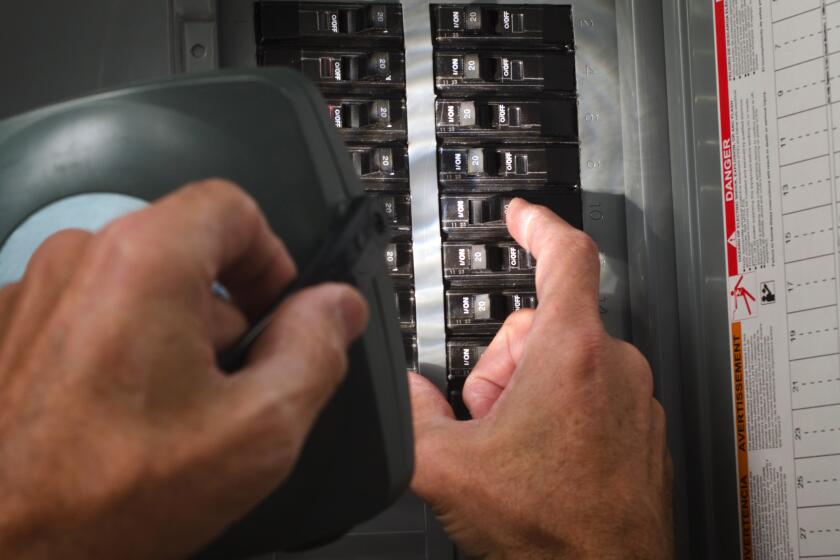L.A. may stop footing bills for sidewalk and driveway repairs
For 15 years, InJu Sturgeon pleaded with the city of Los Angeles to repair the treacherously slanted, cracked and crumbled sidewalk in front of her house in Palms. “I offered to pay 50%,” she said. “I even threatened to sue them.”
But the burden of mending pavement that has been cracked or lifted by expanding tree roots could soon fall to her — and tens of thousands of other Los Angeles property owners.
With cash in short supply, Los Angeles may soon end its policy of repairing sidewalks and driveways at city expense. This month, the City Council will consider repealing a 1974 ordinance that made the city responsible for sidewalk repairs, a policy that was initiated with a grant of federal funds. That pot of money, however, dried up long ago.
“We have no ability to perform these repairs,” said Councilman Bernard C. Parks, chairman of the council’s budget and finance committee. “The money ran out in the mid-1970s, yet the city has continued to hold itself responsible.”
The real-estate industry is girding for a fight. Realtors say the city has done a poor job of explaining its plans to neighborhood councils and homeowners, even though the change could cost many property owners thousands of dollars each.
It could also carry significant legal consequences for property owners.
The city spends $3 million to $5 million a year to defend or settle cases arising from sidewalk-related “trip and fall” injuries. Parks said property owners with damaged sidewalks might ultimately share legal liability for pedestrians who injure themselves. “If you’re put on notice and you do nothing about it,” he said, “it would appear they could share in some of that liability.”
Mel Wilson, housing advocate for the Southland Regional Assn. of Realtors, said he suspects that some insurance companies might refuse to insure property owners with treacherous sidewalks. “It is patently unfair for the [city] to push this forward,” he said. “This has not been given a full airing, and people are going to be upset.”
Of the city’s 10,750 miles of sidewalks, roughly 4,600 miles are in need of repairs, at a projected price of $1.2 billion, said Ron Olive, assistant director of the city’s Bureau of Street Services. Since 2000, the city has spent about $95 million to replace 550 miles of sidewalks.
The council’s budget and finance and public works committees have recommended to the City Council that Los Angeles wait a year before issuing notices to repair sidewalks. They also recommend that the Bureau of Street Services develop a notification and inspection system, draw up a list of contractors who could perform repairs and devise a system for notifying the city when a property is in escrow so repairs could be made at the “point of sale” if the owner has not previously complied.
The recommendations also call for devising a financing system that would let the city borrow funds through a “revenue anticipation bond” with the understanding that the property owner would pay for sidewalk repairs through annual property taxes.
Almost from the time sidewalks began popping up in L.A. neighborhoods in the early 1900s, the city considered property owners responsible for maintaining them.
Up until the 1970s, the city’s typical practice was to inspect sidewalks, cite the property owner and require that repairs be made. If repairs were not made in a timely fashion, the city would repair the pavement and then bill the property owner.
But when federal funds became available, the City Council agreed to repair damage caused by the roots of trees planted between curbs and walkways. In effect, the city assumed responsibility “for most sidewalk repairs,” said Donald Shoup, a UCLA professor of urban planning. Those funds evaporated in 1978, leaving the city without a sidewalk repair program.
In 2005, the city launched a shared-cost program in which residents voluntarily covered a portion of the repairs to move to the front of the line. Last year, city funding for that so-called 50/50 program also ran dry.
The new proposal promises to be a hard sell.
Ahnjel Ali, a Palms resident whose mature magnolia tree has cracked and lifted part of her front walk, called the city’s proposal unfair.
“I didn’t put the tree there,” she said. “I shouldn’t be footing that bill.”
More to Read
Sign up for Essential California
The most important California stories and recommendations in your inbox every morning.
You may occasionally receive promotional content from the Los Angeles Times.







